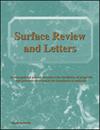CHARACTERIZATION OF CORROSION BEHAVIOR OF INCONEL 617 WELDED JOINTS USING CMT-GMAW MULTI-CONTROL WELDING
IF 1.2
4区 材料科学
Q4 CHEMISTRY, PHYSICAL
引用次数: 0
Abstract
This work addressed the effect of CMT-GMAW multi-control welding of Inconel 617 alloy with different wire feed rates (8.9, 9.4, and 9.9 m/min) on the microstructure, hardness, and electrochemical properties. The weld joints are composed of columnar dendritic structure with cellular crystals. Electron backscattered diffraction (EBSD) study showed equiaxed dendrite at the center of weld metal with growth direction perpendicular to the fusion boundary. The weldments showed diffraction peaks at 43.53[Formula: see text], 50.12[Formula: see text], and 74.82[Formula: see text], and these peaks mainly represent gamma ([Formula: see text]) and gamma prime ([Formula: see text]) phases along with the carbide peaks of Ti (C, N), M[Formula: see text]C 6 and M 6 C. The Base metal (BM) had a lower hardness (232 ± 10 HV[Formula: see text]) and lower corrosion rate (0.212 mpy) than the weld joints. The increase in wire feed rate (WFR) results in the decrease of microhardness (267 ± 5 − 251 ± 6 HV[Formula: see text]) and increase in corrosion rate (1.833-28.140 mpy). The base metal exhibited higher potential ([Formula: see text]) and lower current density ([Formula: see text]) than the weld joints. As wire feed rate (WFR) increases, heat input increases; solidification time increases, grain boundaries coarsen, resulting in a lower grain boundary (GB) density, and hence increased carbide precipitation and segregation in weld zone leading to higher stable anodic current density, which caused corrosion resistance to deteriorating. The BM was more corrosion resistant than the weld joints. The metallurgical and physical changes caused by the welding process affect the corrosion resistance of the weld joints. This leads to the weld metal corroding faster than the base metal.cmt-gmaw多控制焊接inconel 617焊接接头腐蚀行为的表征
研究了不同送丝速度(8.9、9.4和9.9 m/min)下CMT-GMAW多控制焊接对Inconel 617合金显微组织、硬度和电化学性能的影响。焊接接头由柱状枝晶结构和胞状晶体组成。电子背散射衍射(EBSD)研究表明,焊缝金属中心有等轴枝晶,其生长方向垂直于熔合边界。焊缝在43.53[公式:见文]、50.12[公式:见文]和74.82[公式:见文]处出现衍射峰,这些峰主要代表γ([公式:见文])相和γ素([公式:见文])相以及Ti (C, N)、M(公式:见文)c6和m6 C的碳化物峰。母材(BM)的硬度(232±10 HV[公式:见文])和腐蚀速率(0.212 mpy)低于焊缝。随着送丝速率(WFR)的增加,合金显微硬度(267±5 ~ 251±6 HV)降低,腐蚀速率(1.833 ~ 28.140 mpy)增加。母材表现出比焊缝更高的电位([公式:见文])和更低的电流密度([公式:见文])。随着送丝速率(WFR)的增大,热输入增大;凝固时间延长,晶界变粗,导致晶界(GB)密度降低,从而导致焊缝区碳化物析出和偏析增加,导致稳定阳极电流密度升高,导致耐蚀性恶化。BM比焊缝更耐腐蚀。焊接过程中引起的冶金和物理变化影响焊缝的耐腐蚀性能。这导致焊缝金属比母材腐蚀得更快。
本文章由计算机程序翻译,如有差异,请以英文原文为准。
求助全文
约1分钟内获得全文
求助全文
来源期刊

Surface Review and Letters
工程技术-物理:凝聚态物理
CiteScore
2.20
自引率
9.10%
发文量
139
审稿时长
4.2 months
期刊介绍:
This international journal is devoted to the elucidation of properties and processes that occur at the boundaries of materials. The scope of the journal covers a broad range of topics in experimental and theoretical studies of surfaces and interfaces. Both the physical and chemical properties are covered. The journal also places emphasis on emerging areas of cross-disciplinary research where new phenomena occur due to the presence of a surface or an interface. Representative areas include surface and interface structures; their electronic, magnetic and optical properties; dynamics and energetics; chemical reactions at surfaces; phase transitions, reconstruction, roughening and melting; defects, nucleation and growth; and new surface and interface characterization techniques.
 求助内容:
求助内容: 应助结果提醒方式:
应助结果提醒方式:


